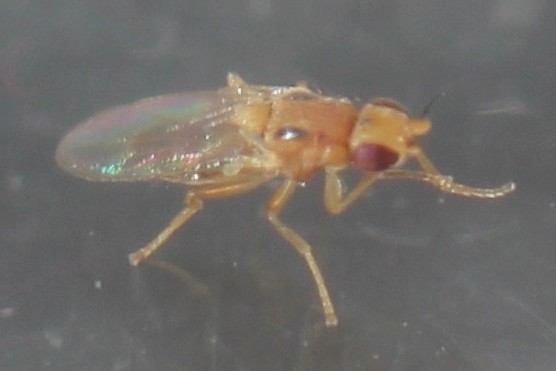Diptera.info :: Identification queries :: Diptera (adults)
|
Elachiptera austriaca
|
|
| jeremyr |
Posted on 04-02-2013 14:27
|
|
Member Location: Tottenham Posts: 577 Joined: 18.05.12 |
This fly in the cemetery today looks like the images of Elachiptera bimaculata in the Chloropidae gallery. No nbn map for this though, so I don't know if it's meant to be in the UK. Is it possible to say what it might be if not bimaculata?
jeremyr attached the following image:  [35.76Kb] Edited by jeremyr on 10-02-2013 00:55 |
|
|
|
| jeremyr |
Posted on 04-02-2013 14:28
|
|
Member Location: Tottenham Posts: 577 Joined: 18.05.12 |
2nd view
jeremyr attached the following image:  [43.35Kb] |
|
|
|
| jeremyr |
Posted on 04-02-2013 14:30
|
|
Member Location: Tottenham Posts: 577 Joined: 18.05.12 |
3rd view
jeremyr attached the following image:  [34.17Kb] |
|
|
|
| Sara21392 |
Posted on 08-02-2013 10:23
|
|
Member Location: Posts: 1445 Joined: 07.11.10 |
True!
Sincerely yours Sara |
|
|
|
| jeremyr |
Posted on 08-02-2013 12:08
|
|
Member Location: Tottenham Posts: 577 Joined: 18.05.12 |
Hi Sara, many thanks indeed for your response. However, bimaculata is not a British species, so it can't be that.. can it??? best wishes, Jeremy |
|
|
|
| empeejay |
Posted on 08-02-2013 15:39
|
|
Member Location: Posts: 234 Joined: 15.05.06 |
I was going to reply to this before but decided to wait to see what others thought. The British species was originally described as Elachiptera uniseta by Collin, which was compared with bimaculata. The main distinguishing character of Collin's species was the single pair of orbital bristles. I have a couple of specimens that I had identified as uniseta using Collin's key to the British species of Elachiptera. However, one of these had 2 pairs of orbital bristles but otherwise looked identical. I've now tried to identify these using Duda's Palaearctic key and the more recent one to the species of the European part of the USSR. Neither really gave a satisfactory answer. Apart from the difference in the number of orbital bristles between my 2 specimens, they have a different number of tubercles on the scutellar margin. The mesonotum doesn't appear to agree with that of austriaca (=uniseta) in the Russian key but the colour of the thoracic pleurae, used by Duda as a distinguishing character, suggests that species rather than bimaculata. Comparing my specimens to those on this forum, they agree more with this one rather than this one. I can't see much detail in your photos but the pleurae are largely pale, quite unlike those of mine and the dark patches on the mesonotum look slightly different. So I wouldn't entirely rule out the possibility of your specimen being bimaculata. It really needs to be checked by an expert. Edited by empeejay on 08-02-2013 15:46 |
|
|
|
| jeremyr |
Posted on 08-02-2013 16:33
|
|
Member Location: Tottenham Posts: 577 Joined: 18.05.12 |
Hi empeejay, thanks for the key reference, I will look that out. I did try to go through the British list but could find no illustration of austriaca. I've just read though that it's a wetland species. This one was in an Ivy bush beside White Hart Lane, although hard by some allotments which do flood yearly Jeremy Edited by jeremyr on 08-02-2013 16:34 |
|
|
|
| empeejay |
Posted on 08-02-2013 18:08
|
|
Member Location: Posts: 234 Joined: 15.05.06 |
Mine were certainly wetland inhabitants. The female from rank marsh vegetation during September in Norfolk and the male from a reed bed during August in Suffolk. I'm quite confident mine are austriaca. No other Elachiptera species currently on the British list has that distinctive appearance. Yours may simply be a pale austriaca. Hopefully the new Chloropidae book will help resolve the issue. |
|
|
|
| Mark-uk |
Posted on 08-02-2013 21:12
|
|
Member Location: UK - Hampshire Posts: 792 Joined: 01.02.10 |
Have you sought John Ismay's veiws? |
|
|
|
| von Tschirnhaus |
Posted on 15-05-2013 12:15
|
|
Member Location: Bielefeld, Germany Posts: 454 Joined: 04.11.07 |
Elachiptera austriaca Duda, 1932 (male), Chloropidae. After the synonymization of E. uniseta Collin, 1939 with austriaca by Wendt (1999) in the German checklist (she studied the types of both taxa), some authors incorrectly continue to treat both taxa as valid, leading to the inclusion in the Hungarian checklist and the Czech fauna. M.v.Tschirnhaus found specimens with two orbital bristles, too (unpublished). The more southerly distributed and very abundant E. bimaculata (Loew, 1845) differs in possessing an arista which is very acute at its tip (austriaca more sword-like till tip) the cheeks of austriaca are more narrowed in front. The species has been reared from bird nests and had been observed to visit the flower cobs of Typha (Typhaceae), adults also overwinter there.
Edited by von Tschirnhaus on 15-05-2013 18:56 |
| jeremyr |
Posted on 15-05-2013 14:50
|
|
Member Location: Tottenham Posts: 577 Joined: 18.05.12 |
that's what I'm sort of stuck on at the moment, my specimen 'appears' to have two pairs of orbital bristles. Bimaculata not a Britsh species
Edited by jeremyr on 15-05-2013 14:50 |
|
|
|
| Jump to Forum: |













